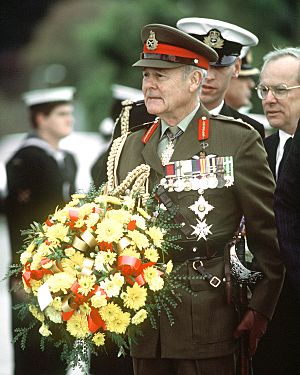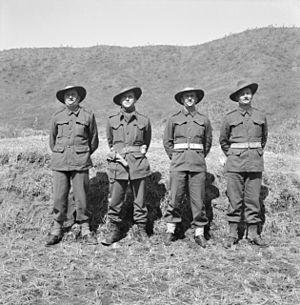Phillip Bennett facts for kids
Quick facts for kids
General
Sir Phillip Bennett
|
|
|---|---|

Bennett in 1992
|
|
| 23rd Governor of Tasmania | |
| In office 19 October 1987 – 2 October 1995 |
|
| Monarch | Elizabeth II |
| Premier | Robin Gray Michael Field Ray Groom |
| Preceded by | Sir James Plimsoll |
| Succeeded by | Sir Guy Green |
| Personal details | |
| Born | 27 December 1928 East Fremantle, Western Australia, Australia |
| Died | 1 August 2023 (aged 94) |
| Spouses | Margaret, Lady Bennett |
| Occupation | Soldier |
| Military service | |
| Allegiance | Australia |
| Branch/service | Australian Army |
| Years of service | 1946–1987 |
| Rank | General |
| Commands | Chief of the Defence Force (1984–87) Chief of General Staff (1982–84) 1st Division (1977–79) 1st Battalion, Royal Australian Regiment (1967–69) 2nd Commando Company (1958–61) |
| Battles/wars | Korean War Malayan Emergency Vietnam War
|
| Awards | Companion of the Order of Australia Knight Commander of the Order of the British Empire Distinguished Service Order Knight of the Order of St John Mentioned in Despatches Commander of the Legion of Merit (United States) |
General Sir Phillip Harvey Bennett (27 December 1928 – 1 August 2023) was an important leader in the Australian Army. He served as the top military officer, known as the Chief of the Australian Defence Force, from 1984 to 1987. After his military career, he became the Governor of Tasmania, a role he held from 1987 to 1995.
Contents
Early Life and Military Training
Phillip Bennett was born in Perth, Western Australia. He went to Perth Modern School and then to the Royal Military College, Duntroon. This college is where future officers for the Australian Army are trained. He graduated as a lieutenant (a junior officer rank) in December 1948.
In March 1949, he was sent to Japan. He joined the 67 Infantry Battalion, which was part of the British Commonwealth Occupation Force. This force helped keep peace in Japan after World War II.
A Distinguished Military Career
Serving in Korea and Beyond
Bennett stayed in Japan until September 1950. He then went to Korea to serve in the Korean War with the 3rd Battalion, Royal Australian Regiment. During his year there, he was injured in October 1950 but kept working. He was also praised for his actions, which is called being Mentioned in Despatches.
He returned to Korea for another year starting in September 1952. He worked as an instructor, teaching junior non-commissioned officers (NCOs) from the Canadian Infantry Brigade.
After returning to Australia in 1953, Bennett became an Adjutant (an administrative officer) for the Royal Pacific Islands Regiment in Papua New Guinea. He also served in the United Kingdom with the Royal Marine Commandos. He saw action in Malta and Cyprus. From 1958 to 1961, he led the 2nd Commando Company.
Leadership in Vietnam
Later, Bennett commanded the 1st Battalion, Royal Australian Regiment. He played a key role in the Battle of Coral–Balmoral during the Vietnam War. This was one of the biggest battles for Australian soldiers in the war. For his brave service in Vietnam from 1968 to 1969, Bennett received the Distinguished Service Order.
Rising Through the Ranks
Bennett continued to advance in his military career. He attended several important training courses for senior officers. In 1974, he was promoted to brigadier. He then commanded the 1st Division from 1977 to 1979.
He became the Chief of the General Staff in 1982. This role meant he was the head of the Australian Army. In 1984, he was promoted to Chief of the Defence Force. This is the highest military position in Australia, leading all parts of the Australian Defence Force. He retired from the Army in April 1987.
Serving as Governor of Tasmania
After his military career, Sir Phillip Bennett became the Governor of Tasmania. This role involves representing the King or Queen in the state and performing important duties.
A Constitutional Challenge
During his time as governor, he faced a difficult political situation in 1989. The state election results were unclear. The Liberal Government, led by Premier Robin Gray, lost its majority. The Labor Party, led by Michael Field, then made an agreement with the five Green members. This agreement, called the Labor-Green Accord, meant Labor could form a minority government.
Premier Gray did not want to resign. He asked Governor Bennett to call a new election. However, Bennett decided not to. He believed Gray no longer had the support to govern. He also knew that the Greens would support a Labor government. Because of this, Gray had to resign, and Bennett asked Michael Field to become the new Premier.
Bennett also sometimes acted as the Administrator of the Commonwealth. This happened when the Governor-General (Australia's highest representative of the King or Queen) was travelling overseas.
Life After Governorship
After finishing his term as Governor, Sir Phillip Bennett remained active in public life. He became the first Chairman of the Australian War Memorial Foundation. He also served as a patron for several important organisations, including the St John Ambulance in the ACT and the Royal Australian Regiment Association. He was also the National President of the Order of Australia Association.
A book about Sir Phillip Bennett's life, titled The Last Knight, was published in 2011.
Death
Sir Phillip Bennett passed away on 1 August 2023, at the age of 94.
Awards and Honours
Sir Phillip Bennett received many awards for his service:
- In 1969, he was awarded the Companion of the Distinguished Service Order (DSO) for his leadership in Vietnam.
- He became an Officer of the Order of Australia (AO) in 1981.
- In 1982, he was made a Knight Commander of the Order of the British Empire (KBE).
- He was promoted to Companion of the Order of Australia (AC) in 1985, which is a very high honour.
- He was Mentioned in Despatches in 1951 for his work as a mortar platoon commander in Korea.
- In 1983, he received the Commander of the US Legion of Merit from the United States.
- He was also awarded the Republic of Korea Order of National Security Medal in 1985.
- He received honorary law degrees from the University of New South Wales (1995) and the University of Tasmania (1992) for his contributions.
- In 1988, he was made a Knight of St John.
- He received the Centenary Medal in 2001.
Images for kids




